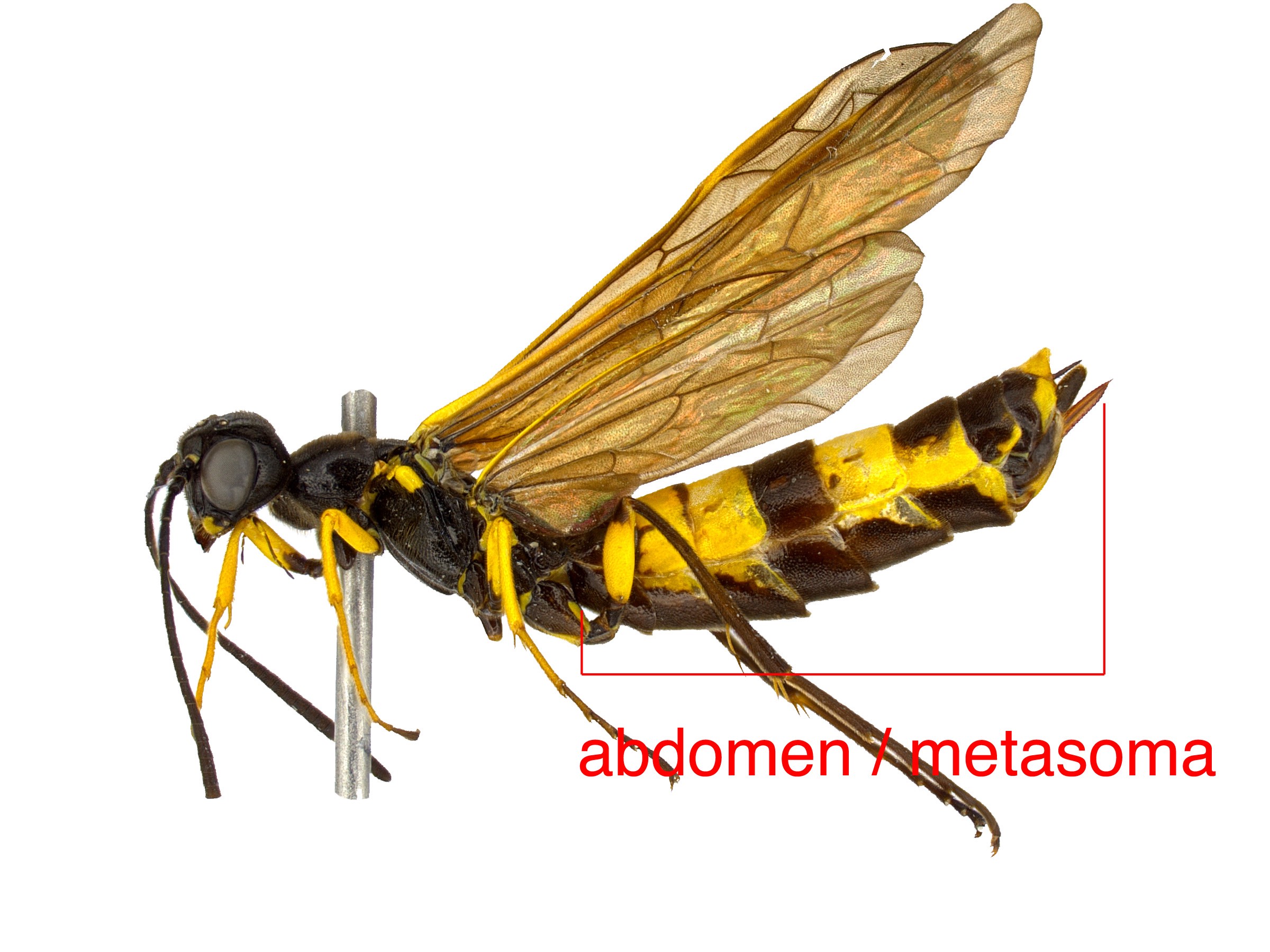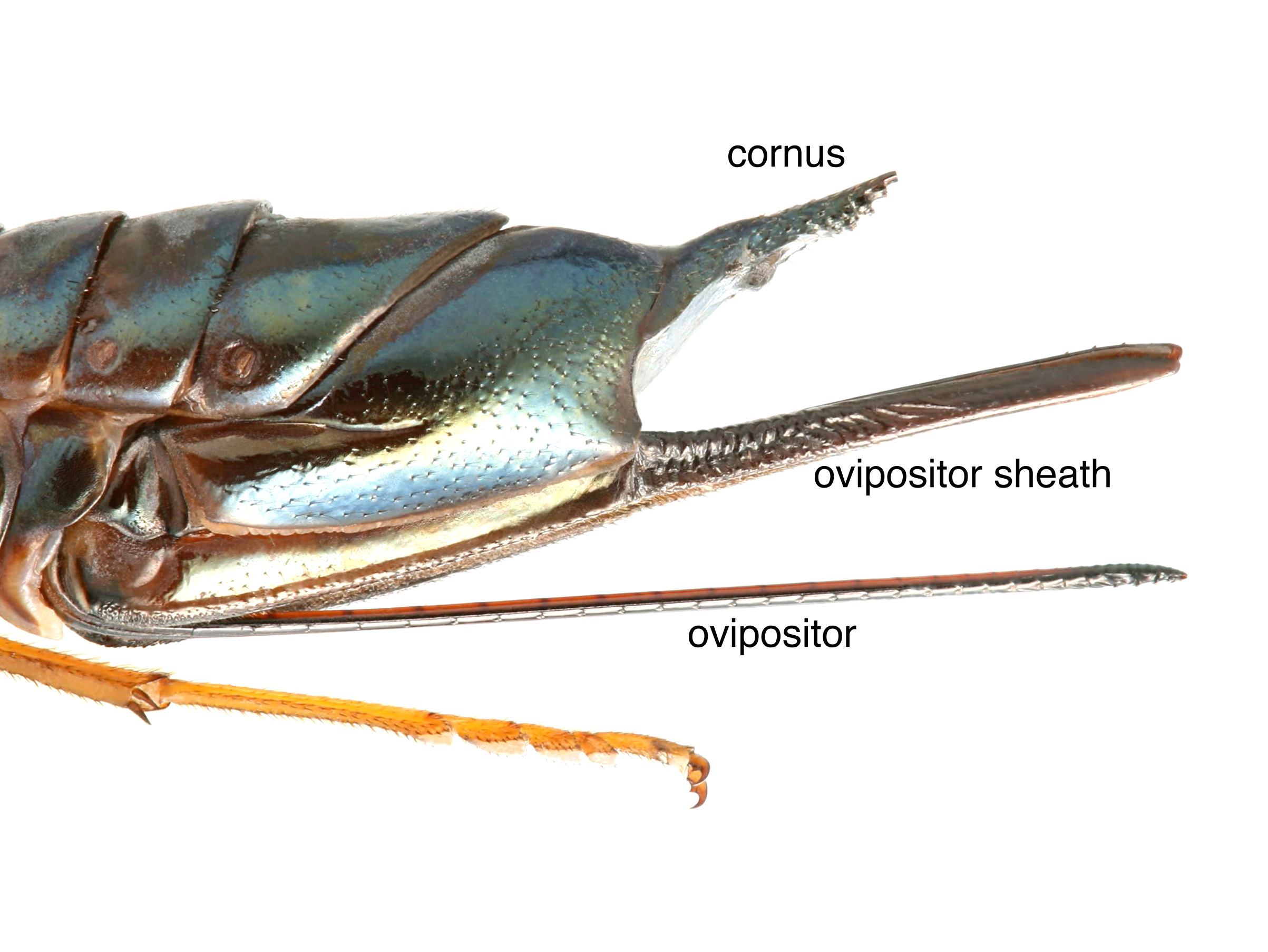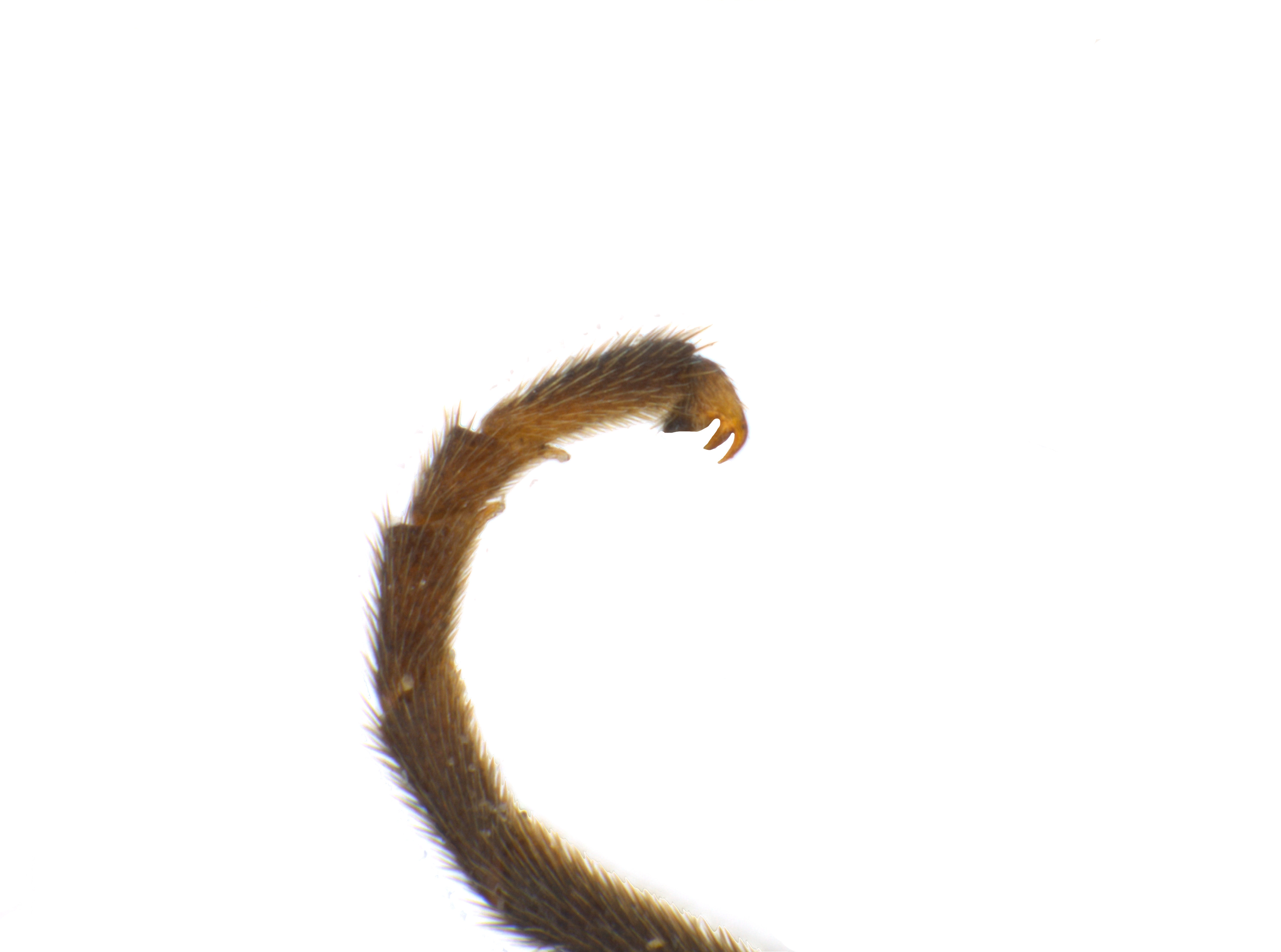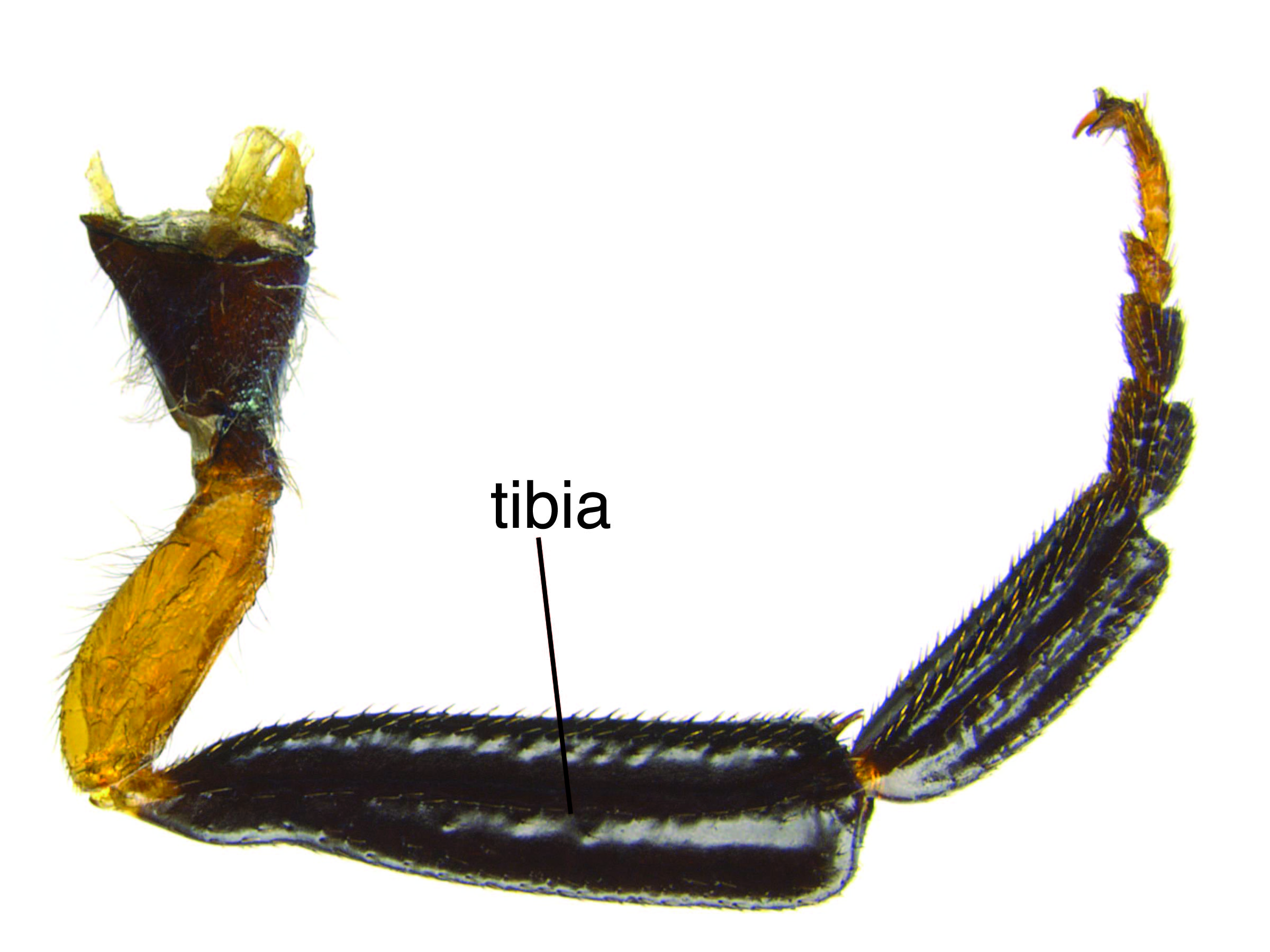Family: Cephidae
Family common name: stem sawflies
Subfamily: Cephinae
Genus: Caenocephus Konow, 1896
Subgenera: none
The Cephidae are commonly known as stem sawflies because larvaelarva:
the immature stage of holometabolous insects
 feed and live within the stems of small herbaceousherbaceous:
feed and live within the stems of small herbaceousherbaceous:
describing a plant that does not have a woody stem and is often close to the ground; e.g., grasses, forbs, and vegetable plants
and woody plants. Many are considered pests, since this feeding behavior can damage or kill the plant host (Shanower and Hoelmer 2004Shanower and Hoelmer 2004:
Shanower TG and Hoelmer KA. 2004. Biological control of wheat stem sawflies: past and future. Journal of Agricultural and Urban Entomology 21 (4): 197-221.).
Stem sawflies of the genus Caenocephus are generally black and slender, with slightly laterally compressed cylindrical bodies. The length of the abdomenabdomen:
the third and last segment of an insect's body; in sawflies this is usually made up of 11 segments (segments 9 and 10 often fused) is about equal or slightly longer than the head and thoraxthorax:
is about equal or slightly longer than the head and thoraxthorax:
the second and middle segment of the body, between the head and abdomen
 together, and females have a short ovipositorovipositor:
together, and females have a short ovipositorovipositor:
the female organ that deposits eggs and is used to drill into plant tissue, located at the apex of the abdomen, made up of the lance and lancet
 . Males and females sometimes have very different coloration, so it is more reliable to distinguish sex by the presence or absence of the ovipositorovipositor:
. Males and females sometimes have very different coloration, so it is more reliable to distinguish sex by the presence or absence of the ovipositorovipositor:
the female organ that deposits eggs and is used to drill into plant tissue, located at the apex of the abdomen, made up of the lance and lancet
 (Ries 1937Ries 1937:
(Ries 1937Ries 1937:
Ries DT. 1937. A revision of the Nearctic Cephidae (Hymemoptera: Tenthredinoidea). The American Entomological Society 63 (3): 259-327.). Caenocephus species are among the largest Cephidae and can be up to 20 mm in length (Smith 1986).
Worldwide, there are only five species, restricted to the Northern Hemisphere. One endemicendemic:
both native and unique to a particular region
species occurs in North America (Taeger et al. 2010Taeger et al. 2010:
Taeger A, Blank SM, and Liston AD. 2010. World Catalog of Symphyta (Hymenoptera). Zootaxa 2580: 1-1064.).
 and mandibles asymmetrical, larger on the right side (Ries 1937Ries 1937:
and mandibles asymmetrical, larger on the right side (Ries 1937Ries 1937: tarsal claws, slightly curved with a distinct lobe at the basebase:
tarsal claws, slightly curved with a distinct lobe at the basebase: with slight expansion in the middle (Ries 1937Ries 1937:
with slight expansion in the middle (Ries 1937Ries 1937: (Ries 1937Ries 1937:
(Ries 1937Ries 1937:Caenocephus can be confused with other Cephidae. The most reliable character that distinguishes this genus from others in the family is the lack of preapicalpreapical:
close to, but anterior to, the apex
 spurs on the hind tibiaetibia:
spurs on the hind tibiaetibia:
the fourth segment of the leg, between the femur and the tarsus
 . Additionally, this genus has an uncommon swelling at the basebase:
. Additionally, this genus has an uncommon swelling at the basebase:
the beginning or most proximal area of any structure
of the tarsal claws (Ries 1937Ries 1937:
Ries DT. 1937. A revision of the Nearctic Cephidae (Hymemoptera: Tenthredinoidea). The American Entomological Society 63 (3): 259-327.).
none
In North America, the only confirmed host plant for Caenocephus aldrichi is Holodiscus discolor (ocean spray) (Hanson and Miller 1988Hanson and Miller 1988:
Hanson PE and Miller JC. 1988. Notes on the biology of Caenocephus aldrichi Bradley (Hymenoptera: Cephidae). Proceedings of the Entomological Society of Washington 90 (2): 204-206.). Middlekauff (1969) suggests a record from Conium maculatum (poison hemlock), but this host is unconfirmed.
Female Caenocephus oviposit into stems of shrubs (Middlekauff 1969Middlekauff 1969:
Middlekauff WW. 1969. The cephid stem borers of California (Hymenoptera: Cephidae). Bulletin of the California Insect Survey 2: 1-25.). After hatching, larvaelarva:
the immature stage of holometabolous insects
 girdle the stem above by chewing in a line along the inner wall and interrupting the vascular system (Hanson and Miller 1988Hanson and Miller 1988:
girdle the stem above by chewing in a line along the inner wall and interrupting the vascular system (Hanson and Miller 1988Hanson and Miller 1988:
Hanson PE and Miller JC. 1988. Notes on the biology of Caenocephus aldrichi Bradley (Hymenoptera: Cephidae). Proceedings of the Entomological Society of Washington 90 (2): 204-206.). The larvaelarva:
the immature stage of holometabolous insects
 feed on the vascular tissue of the plant, moving downwards towards the basebase:
feed on the vascular tissue of the plant, moving downwards towards the basebase:
the beginning or most proximal area of any structure
(Shanower and Hoelmer 2004Shanower and Hoelmer 2004:
Shanower TG and Hoelmer KA. 2004. Biological control of wheat stem sawflies: past and future. Journal of Agricultural and Urban Entomology 21 (4): 197-221.). LarvaeLarva:
the immature stage of holometabolous insects
 are creamy white and grub-like in appearance. They lack abdominal prolegs, and thoracicthoracic:
are creamy white and grub-like in appearance. They lack abdominal prolegs, and thoracicthoracic:
of or on the thorax
legs are vestigial. Cephidae larvaelarva:
the immature stage of holometabolous insects
 possess a tubular dorsaldorsal:
possess a tubular dorsaldorsal:
of or on the top surface of the body or structure
horn on the posterior end of the body (Middlekauff 1969Middlekauff 1969:
Middlekauff WW. 1969. The cephid stem borers of California (Hymenoptera: Cephidae). Bulletin of the California Insect Survey 2: 1-25.). As the larvaelarva:
the immature stage of holometabolous insects
 feed, they use this horn to pack frassfrass:
feed, they use this horn to pack frassfrass:
solid larval excrement
in the gallery behind them. At the basebase:
the beginning or most proximal area of any structure
of the branch, or after the tunnel reaches 1–5 cm, the larvaelarva:
the immature stage of holometabolous insects
 turn around and girdle the stem a second time. Once the plant above the girdle weakens and dies, it breaks off, leaving a stub topped with a frassfrass:
turn around and girdle the stem a second time. Once the plant above the girdle weakens and dies, it breaks off, leaving a stub topped with a frassfrass:
solid larval excrement
plug, keeping the larvalarva:
the immature stage of holometabolous insects
 safe inside (Shanower and Hoelmer 2004Shanower and Hoelmer 2004:
safe inside (Shanower and Hoelmer 2004Shanower and Hoelmer 2004:
Shanower TG and Hoelmer KA. 2004. Biological control of wheat stem sawflies: past and future. Journal of Agricultural and Urban Entomology 21 (4): 197-221., Hanson and Miller 1988Hanson and Miller 1988:
Hanson PE and Miller JC. 1988. Notes on the biology of Caenocephus aldrichi Bradley (Hymenoptera: Cephidae). Proceedings of the Entomological Society of Washington 90 (2): 204-206.).
Larvae generally undergo a period of diapausediapause:
a non-active period of no development; sawflies often enter diapause as a prepupa or pupa to overwinter
, either over winter or through a dry season, then pupate inside the stub. The adult chews or pushes its way out of the stub via the frassfrass:
solid larval excrement
plug and emerges. Little is known about the adult behavior of this genus (Hanson and Miller 1988Hanson and Miller 1988:
Hanson PE and Miller JC. 1988. Notes on the biology of Caenocephus aldrichi Bradley (Hymenoptera: Cephidae). Proceedings of the Entomological Society of Washington 90 (2): 204-206.).
World: Caenocephus species are found throughout the Northern Hemisphere, with most species unique to their range. The genus occurs in North America, Europe, North Africa, and East and Southeast Asia (Taeger et al. 2010Taeger et al. 2010:
Taeger A, Blank SM, and Liston AD. 2010. World Catalog of Symphyta (Hymenoptera). Zootaxa 2580: 1-1064.).
North America: Caenocephus aldrichi occurs in the Pacific Northwest, with records in British Columbia, Washington, Oregon, California, and Idaho (Middlekauff 1969Middlekauff 1969:
Middlekauff WW. 1969. The cephid stem borers of California (Hymenoptera: Cephidae). Bulletin of the California Insect Survey 2: 1-25., Taeger et al. 2010Taeger et al. 2010:
Taeger A, Blank SM, and Liston AD. 2010. World Catalog of Symphyta (Hymenoptera). Zootaxa 2580: 1-1064.).
Map data from: GBIF.org (26 June 2019) GBIF Occurrence Download Caenocephus
Details about data used for maps can be found here.